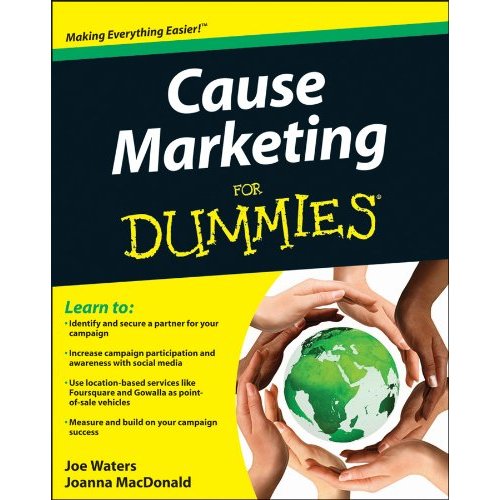
Both nonprofits and small businesses stand to gain a lot from cause marketing. As you know, that’s a partnership between a business and a nonprofit to raise money for the nonprofit and attract new customers or more sales for the business. For big examples, think Project(RED) and its partnerships with clothing manufacturers. Or Home Depot and KaBOOM building playgrounds together.
But cause marketing isn’t only for the big guys; small businesses who care about their communities and small nonprofits who serve those communities can do a lot of good for each other.
If you want to understand what cause marketing is and what it can do — for both the business and the nonprofit partner — check out Cause Marketing for Dummies by Joe Waters, who writes the Selfish Giving blog. The book gives a good overview of the nuts and bolts of cause marketing, from time lines to staff training to the intricacies of online cause marketing.
This book isn’t for the CEO of Home Depot. It’s for small businesses that want to do some local good: The pizza parlor that donates a portion of its proceeds to the local free clinic or the hardware store that donates paint and volunteer labor to rehab a homeless shelter.
Yes, in-kind donations and employee sweat equity count as cause-marketing efforts. Waters lays out all kinds of cause-marketing ideas, from the donation can at the cash register to licensing agreements, including non-cash arrangements.
The book is an easy read, chock full of important information such as the statistics that show both nonprofits and businesses why they should engage in cause marketing. Those stats are impressive:
- In 2010, cause marketing was a $1.62 billion industry, up from $120 million in 1990.
- 83% of Americans want to buy products and services that support causes.
- Nearly half the consumers in one study said that companies should focus on issues that impact local communities.
Take note of that last one: local causes matter, which means local businesses can benefit from cause marketing. Consumers expect all businesses, large and small, to be socially responsible. And it’s not asking too much. Small businesses have been socially responsible for eons; they just may not have advertised the good they were doing. But successful entrepreneurs know that doing good matters, even when you are just starting out.
For nonprofits, the public’s interest in making a difference while making a purchase can translate into new revenue, much needed as government funding dries up.
Waters’ book gives both small businesses and nonprofits a heads-up about the pitfalls of cause-marketing and clear steps for avoiding them. He includes a generous list of resources, both online and off, so you can take the first step toward cause marketing: educating yourself.
For those who’d rather hear and see, Waters will be presenting a free webinar for Ventureneer, Top Tech Tools for Nonprofit and Business Partnerships on Wednesday, September 21, 12n-1pm ET.
How does your small business show its support for the community?
